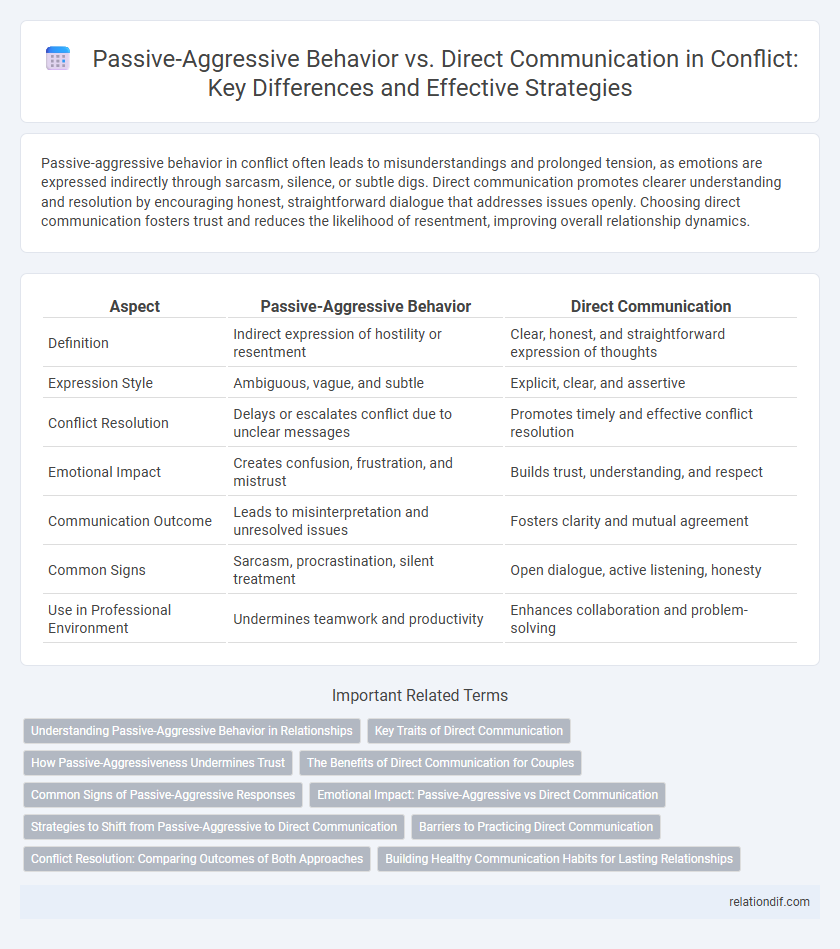Passive-aggressive behavior in conflict often leads to misunderstandings and prolonged tension, as emotions are expressed indirectly through sarcasm, silence, or subtle digs. Direct communication promotes clearer understanding and resolution by encouraging honest, straightforward dialogue that addresses issues openly. Choosing direct communication fosters trust and reduces the likelihood of resentment, improving overall relationship dynamics.
Table of Comparison
| Aspect | Passive-Aggressive Behavior | Direct Communication |
|---|---|---|
| Definition | Indirect expression of hostility or resentment | Clear, honest, and straightforward expression of thoughts |
| Expression Style | Ambiguous, vague, and subtle | Explicit, clear, and assertive |
| Conflict Resolution | Delays or escalates conflict due to unclear messages | Promotes timely and effective conflict resolution |
| Emotional Impact | Creates confusion, frustration, and mistrust | Builds trust, understanding, and respect |
| Communication Outcome | Leads to misinterpretation and unresolved issues | Fosters clarity and mutual agreement |
| Common Signs | Sarcasm, procrastination, silent treatment | Open dialogue, active listening, honesty |
| Use in Professional Environment | Undermines teamwork and productivity | Enhances collaboration and problem-solving |
Understanding Passive-Aggressive Behavior in Relationships
Passive-aggressive behavior in relationships often manifests through indirect resistance, sarcasm, and subtle undermining rather than open confrontation, creating confusion and emotional distance. This form of communication can mask underlying feelings of anger or resentment, making it difficult for partners to address core issues effectively. Recognizing these patterns enables healthier conflict resolution by encouraging direct communication, fostering transparency, and building trust within the relationship.
Key Traits of Direct Communication
Direct communication is characterized by clarity, honesty, and assertiveness, enabling individuals to express their thoughts and feelings openly without ambiguity. This approach fosters mutual understanding, reduces misunderstandings, and promotes resolution by addressing issues head-on. Key traits include maintaining respectful tone, providing specific feedback, and actively listening to others' perspectives.
How Passive-Aggressiveness Undermines Trust
Passive-aggressive behavior erodes trust by creating confusion and doubt about true intentions, leading to misinterpretation and resentment. Unlike direct communication, which fosters transparency and mutual understanding, passive-aggressiveness breeds suspicion and emotional distance. Consistent lack of openness weakens relationships and impairs effective conflict resolution.
The Benefits of Direct Communication for Couples
Direct communication in couples fosters clarity and reduces misunderstandings, promoting emotional intimacy and trust. Couples who practice open expression of feelings and needs experience fewer unresolved conflicts and increased relationship satisfaction. Emphasizing honest dialogue over passive-aggressive behavior supports healthier conflict resolution and long-term relationship stability.
Common Signs of Passive-Aggressive Responses
Passive-aggressive behavior often manifests through indirect expressions of hostility, such as sarcasm, procrastination, or silent treatment, which contrast with the clarity of direct communication. Common signs include subtle undermining, avoidance of confrontation, and vague or ambiguous responses that mask true feelings. Recognizing these behaviors is essential for improving conflict resolution and fostering open dialogue.
Emotional Impact: Passive-Aggressive vs Direct Communication
Passive-aggressive behavior often leads to confusion, resentment, and prolonged emotional distress as feelings are indirectly expressed and unresolved conflicts linger. Direct communication promotes emotional clarity by expressing feelings openly, reducing misunderstandings and fostering trust. Studies show that direct communication improves emotional well-being and conflict resolution outcomes compared to passive-aggressive interactions.
Strategies to Shift from Passive-Aggressive to Direct Communication
Shifting from passive-aggressive behavior to direct communication involves practicing assertiveness by clearly expressing thoughts and feelings without hostility. Implementing active listening and using "I" statements helps to reduce misunderstandings and fosters open dialogue. Establishing boundaries and seeking feedback promotes accountability and builds trust in conflict resolution.
Barriers to Practicing Direct Communication
Barriers to practicing direct communication in conflict often stem from fear of confrontation, cultural norms, and lack of emotional awareness, leading individuals to resort to passive-aggressive behavior. This indirect expression of hostility creates misunderstandings, erodes trust, and prolongs conflict resolution. Overcoming these barriers requires conscious effort to develop assertiveness skills, emotional intelligence, and a safe environment fostering open dialogue.
Conflict Resolution: Comparing Outcomes of Both Approaches
Passive-aggressive behavior often escalates conflicts by creating ambiguity and fostering resentment, which impedes resolution and damages relationships. Direct communication facilitates clearer understanding, promotes transparency, and enables effective problem-solving, leading to more constructive conflict resolution outcomes. Studies show that direct communication correlates with higher satisfaction and quicker resolution in workplace and personal conflicts.
Building Healthy Communication Habits for Lasting Relationships
Passive-aggressive behavior undermines trust and escalates conflict by masking true feelings, while direct communication promotes clarity and mutual understanding essential for resolving disputes. Building healthy communication habits involves expressing emotions honestly and respectfully, fostering an environment where all parties feel heard and valued. Consistent use of direct communication strengthens relationships by reducing misunderstandings and encouraging collaborative problem-solving.
Passive-aggressive behavior vs Direct communication Infographic

 relationdif.com
relationdif.com